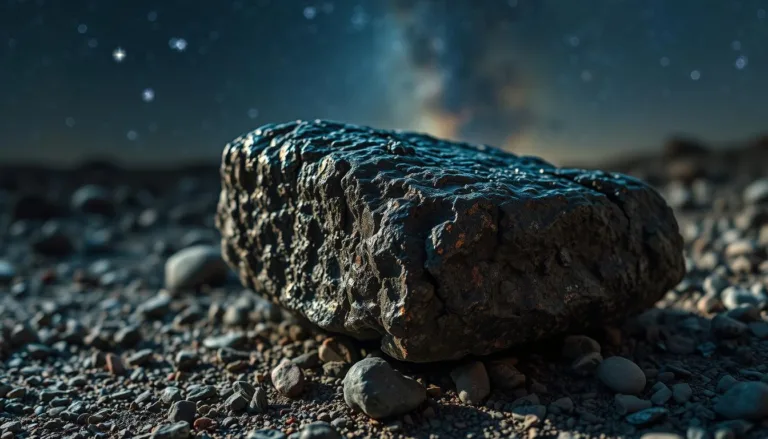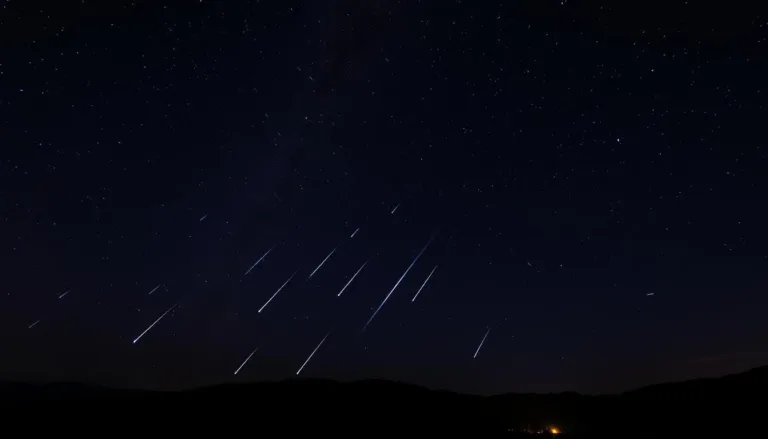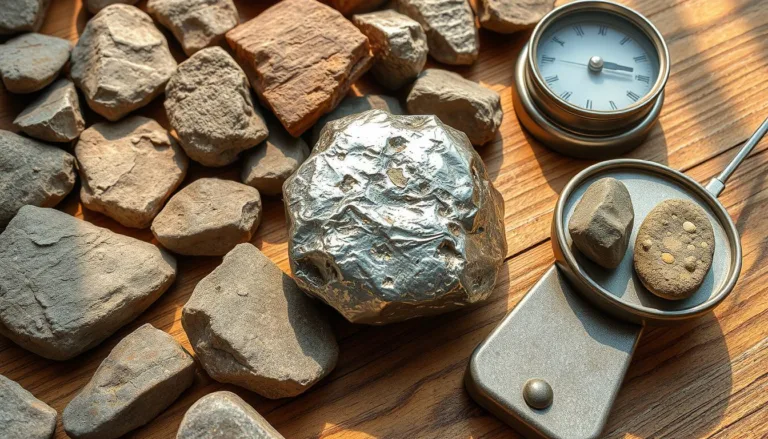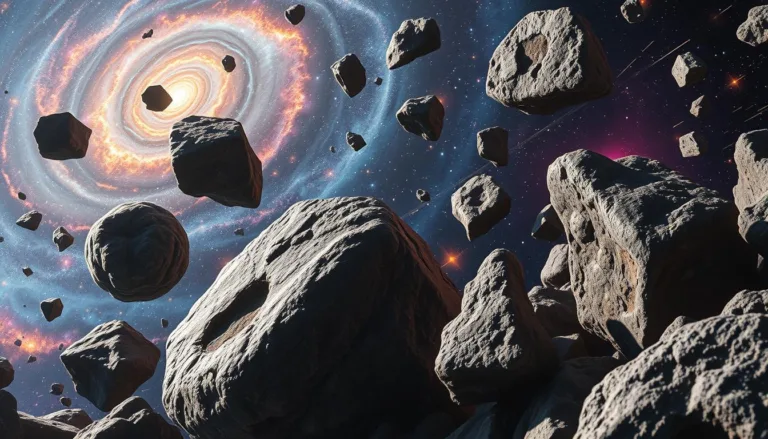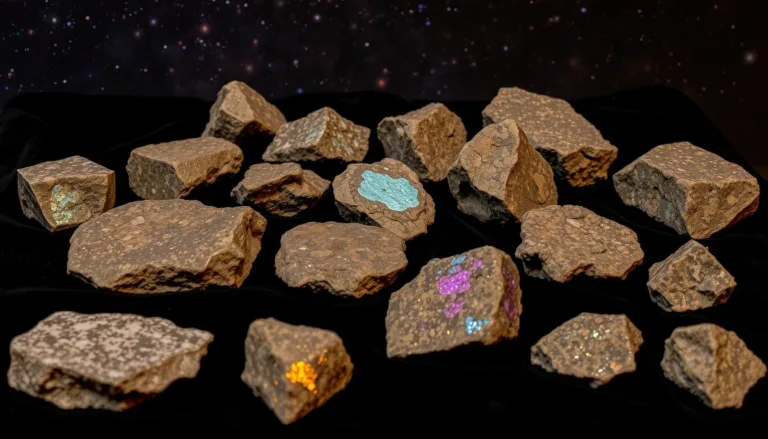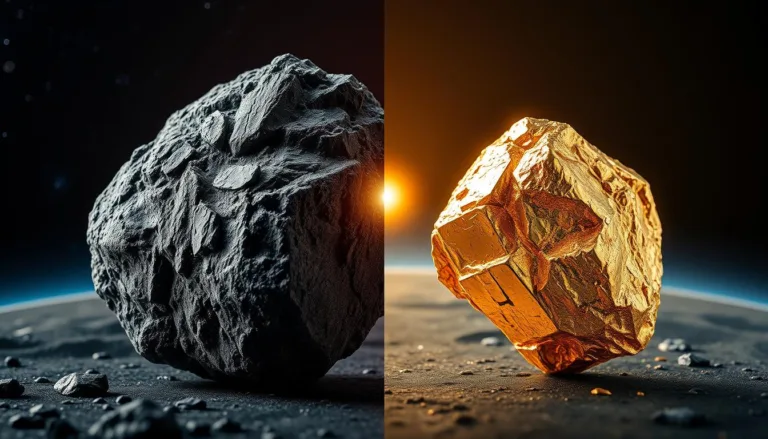We’re excited to share the amazing world of meteorites with you. We’ll cover everything you need to know about these space rocks. Meteorites help us understand our solar system’s history and evolution.
Let’s dive into the basics of meteorites. We’ll talk about what they are, where they come from, and why they’re important. Our aim is to spark your curiosity and encourage you to learn more about meteorites.
Introduction to Meteorites
Meteorites are pieces of asteroids or other space bodies that make it to Earth. By studying these rocks, scientists can uncover secrets about our solar system. This knowledge helps us understand the universe better.
Key Takeaways
- Meteorites are fragments of asteroids or other celestial bodies that have entered Earth’s atmosphere
- Studying meteorites provides valuable insights into the formation and evolution of our solar system
- Meteorites are a unique source of meteorite information and can help us better understand the universe
- Continued research and discovery in the field of meteorites is essential for advancing our knowledge
- Meteorites are an important part of our planet’s history and can help us learn about the composition and structure of celestial bodies
What Are Meteorites: Understanding These Celestial Visitors
Meteorites are pieces of asteroids or other space bodies that land on Earth. They come in three main types: stony, iron, and stony-iron. Each type has its own look that helps us tell them apart.
To spot meteorites, we look for signs like fusion crust and shock veins. Studying them helps us learn about our solar system’s history. This makes knowing how to identify them very important.
The Journey from Space to Earth
Meteorites come from asteroids, comets, and planets. On their way to Earth, they get very hot and form a fusion crust.
Distinguishing Meteorites from Earth Rocks
There are a few ways to tell meteorites from Earth rocks. We check their density, if they’re magnetic, and if they have special minerals. These clues help us figure out what kind of meteorite it is and where it came from.
The Scientific Significance of Meteorite Studies
Studying meteorites helps us understand our solar system better. By looking at their makeup, we learn about our planet’s past. This knowledge helps us identify and sort meteorites.
| Meteorite Type | Characteristics |
|---|---|
| Stony Meteorites | Primarily composed of silicate minerals |
| Iron Meteorites | Mainly composed of iron and nickel |
| Stony-Iron Meteorites | Mixture of silicate minerals and iron-nickel alloys |
The Ancient History of Meteorite Discovery
We explore the ancient views on meteorites, a journey through myth and science. Meteorites were seen as signs of divine power and mysterious events. This shows how deeply these objects were connected to ancient cultures.
The Chinguetti meteorite is a key example, now at the British Museum. It dates back to around 1000 BC. Our ancestors used it to make tools, showing their resourcefulness and creativity.
As we learn more about meteorites, we understand their place in history better. Here are some important moments in meteorite discovery:
- Ancient Greek philosopher Aristotle called them “stones from the sky.”
- The Roman naturalist Pliny the Elder wrote about a meteorite fall in 467 BC.
- In ancient China, meteorites were seen as having magical powers and were used in medicine.
Studying meteorite history helps us see how our understanding has grown. As we keep learning, we must also protect these valuable resources for the future.
| Meteorite | Location | Date |
|---|---|---|
| Chinguetti | Mauritania | 1000 BC |
| Hoba | Namibia | 80,000 years ago |
| Tunguska | Russia | 1908 |
Classification of Meteorites: A Scientific Overview
Meteorites have long fascinated us. Knowing how to classify them is key to studying them. There are three main types, each with its own features. Studying these types helps us learn about our solar system’s history.
Scientists look at a meteorite’s makeup, structure, and where it came from. This helps them figure out what kind of meteorite it is. For instance, stony meteorites are common and made of silicate minerals.
Stony Meteorites
Stony meteorites make up about 90% of all meteorites. They are mostly made of silicate minerals. They can be split into two groups: chondrites and achondrites.
Iron Meteorites
Iron meteorites are mostly iron and nickel. They likely come from asteroid cores. They are less common, making up about 5% of meteorites.
Stony-Iron Meteorites
Stony-iron meteorites mix stony and iron types. They have both silicate minerals and iron-nickel alloys. They are rare, making up about 1% of meteorites.
Understanding meteorite types is vital for studying them. It helps us learn about our solar system’s history. By studying each type, scientists can uncover more about the universe.
The Chemical Composition of Different Meteorite Types
Studying meteorites helps us understand our solar system’s origins. The makeup of meteorites is key to this understanding. They contain elements like iron, nickel, and silicates, which tell us about their formation.
Meteorites fall into three main types: stony, iron, and stony-iron. Each type has its own mix of elements. Stony meteorites are mostly silicates, iron meteorites are iron and nickel, and stony-iron meteorites are a mix of both.
- Stony meteorites: primarily composed of silicates, such as olivine and pyroxene
- Iron meteorites: mostly iron and nickel, with small amounts of other elements
- Stony-iron meteorites: a mix of silicates and iron-nickel alloys
By studying meteorite composition, scientists can piece together our solar system’s history. The types and amounts of elements found in meteorites tell us about the solar system’s formation and evolution. For instance, iron and nickel in iron meteorites suggest they came from a planet’s core.

The study of meteorite composition is ongoing, with new discoveries and techniques expanding our knowledge. As we keep exploring and analyzing meteorites, we may learn more about our solar system’s formation and evolution.
| Meteorite Type | Primary Composition |
|---|---|
| Stony | Silicates (olivine, pyroxene) |
| Iron | Iron and nickel |
| Stony-iron | Mix of silicates and iron-nickel alloys |
Famous Meteorite Findings Throughout History
History is filled with significant meteorite discoveries. These have greatly helped us understand rare meteorites and their impacts. These events have also caught the eye of scientists and the public alike.
Some of the most notable meteorite findings include:
- The Tunguska event, which is believed to have been caused by a large meteorite that exploded over Siberia
- The Chelyabinsk meteorite, which entered Earth’s atmosphere and exploded over Russia, injuring hundreds of people
- The Hoba meteorite, which is one of the largest known meteorites to have fallen to Earth, with a weight of over 60 tons
These events show how important meteorites are in understanding space hazards. By studying rare meteorites, we learn a lot about our solar system’s formation and evolution.
As we keep exploring meteorites, we see how crucial this research is. It helps us understand the universe better. The study of meteorites is ongoing, with new discoveries adding to our knowledge of space and its risks.
Essential Tools and Techniques for Meteorite Hunting
Meteorite hunting is an exciting adventure that needs preparation and the right tools. It’s important to know the essential equipment and techniques for a successful hunt. We’ll cover the necessary gear, best locations, and safety tips for a rewarding and safe journey.
Having the right equipment is key for meteorite hunting. You’ll need metal detectors, magnifying glasses, and hand lenses to check potential meteorites. Knowing the terrain and geology of the area is also crucial for success.
Required Equipment
- Metal detectors
- Magnifying glasses
- Hand lenses
- Geology maps
- First aid kit
For meteorite hunting, finding the best locations is vital. Look for deserts, craters, and areas with little vegetation. Always remember safety, including wearing the right clothes, staying hydrated, and being prepared for emergencies.
The Market Value of Meteorites
Several factors determine the market value of meteorites. We look at the rarity, size, type, and condition of each meteorite. The rarity of a meteorite is key, as some are rarer than others. For example, stony-iron meteorites are less common than stony meteorites, which affects their value.
The size of the meteorite is also important. Larger meteorites are usually more valuable than smaller ones. The type of meteorite, like iron or stony, also impacts its value. The condition of the meteorite, including preservation and any damage, is crucial too.
Some key factors that influence the market value of meteorites include:
- Rarity
- Size
- Type
- Condition
These factors greatly affect the market value of a meteorite. This makes some meteorites highly sought after by collectors and researchers.
Understanding the market value of meteorites offers insights into their cultural and scientific importance. As we learn more about these celestial visitors, their value is expected to grow. This makes them a fascinating field of study and collection.
Scientific Research and Laboratory Analysis Methods
Scientists use many methods to study meteorites in labs. They look at the meteorite’s makeup to learn about the solar system’s start. They also study how meteorites hit Earth to understand their past.
Some key techniques include:
- Dating techniques, such as radiometric dating, to determine the age of the meteorite
- Composition analysis, which involves examining the chemical makeup of the meteorite
- Structure studies, which examine the internal and external characteristics of the meteorite
These methods help scientists piece together the meteorite’s story. From its birth in space to its landing on Earth, they learn a lot. By studying these, they understand the early solar system better.

Lab work helps scientists uncover meteorite secrets. They learn about the solar system’s history by looking at meteorite composition and impacts. This way, they can tell the story of how our planet and others were formed.
| Technique | Description |
|---|---|
| Dating techniques | Used to determine the age of the meteorite |
| Composition analysis | Examines the chemical makeup of the meteorite |
| Structure studies | Examines the internal and external characteristics of the meteorite |
Meteorite Impact Craters on Earth
We’ve found many meteorite impact craters worldwide. Each one tells us about the history of meteorite impacts on Earth. These craters form when a meteor hits the ground, causing huge damage and leaving a crater. Studying them helps us understand how meteorite impacts affect our planet and life.
Some famous craters include the Chicxulub crater in Mexico, the Vredefort crater in South Africa, and the Acraman crater in Australia. These craters are big and show the harm meteorite impacts can do. For instance, the Chicxulub crater might have helped wipe out the dinosaurs.
- They can be found on every continent on Earth
- They range in size from a few meters to hundreds of kilometers in diameter
- They are formed when a meteorite enters Earth’s atmosphere and strikes the surface
- They can provide valuable insights into the history of meteorite impacts on our planet
By looking at meteorite impact craters, we learn more about the dangers of meteorite impacts. This knowledge helps us protect our planet and keep our species alive.
| Crater Name | Location | Diameter |
|---|---|---|
| Chicxulub | Mexico | 180 km |
| Vredefort | South Africa | 300 km |
| Acraman | Australia | 90 km |
Building and Maintaining a Meteorite Collection
As meteorite collectors, we know how vital it is to care for our specimens. This ensures their value and longevity. Building a collection means more than just getting meteorites. It also means creating a safe space to protect them from harm.
Storage Requirements
Storing meteorites right is key to keeping them in good shape. Meteorite collectors should keep their specimens in a cool, dry spot. This keeps them away from sunlight and moisture, preventing rust and damage.
Documentation Methods
Keeping accurate records is crucial for meteorite collectors. This includes noting the meteorite’s origin, type, and history. Detailed records help prove the authenticity and worth of the specimens.
Preservation Techniques
To keep meteorites safe for the future, collectors use different methods. They might coat the surface or store them in a controlled area. These steps help keep the collection’s integrity and value.

By following these tips, meteorite collectors can create and keep a valuable collection. This collection will be meaningful for years to come.
Legal Aspects of Meteorite Collecting and Trading
When we collect and trade meteorites, we must follow the law. This is to avoid any trouble. The rules about meteorite collecting and trading change by country. So, it’s key to know the laws in our area.
Some important laws and rules to think about include:
- International agreements: Like the Antarctic Treaty, which controls meteorite collecting in Antarctica.
- National laws: For example, the United States’ Meteorite Act, which manages meteorite collection and trade in the US.
- Export regulations: These rules guide the movement of meteorites from one country to another.
It’s also vital to think about the ethical considerations of meteorite collecting and trading. We should make sure we’re not harming the environment or disrespecting indigenous peoples’ rights. Knowing the legal side of meteorite collecting and trading helps us enjoy this hobby responsibly.
Conclusion: The Enduring Mystery and Wonder of Meteorites
As we wrap up our exploration of meteorites, we see their lasting mystery and wonder. These celestial visitors are more than just scientific wonders. They connect us to our solar system’s past, helping us understand today and tomorrow.
Exploring meteorites has given us many insights. We’ve learned about the universe’s makeup, structure, and age. Events like the Tunguska and Chelyabinsk meteorites have amazed scientists and the public. They spark our curiosity about our cosmic beginnings.
The study and care of these rare meteorites are key to our scientific growth. They inspire new scientists in fields like astronomy and geology. By loving meteorites, we spark a global passion for discovery and exploration.


